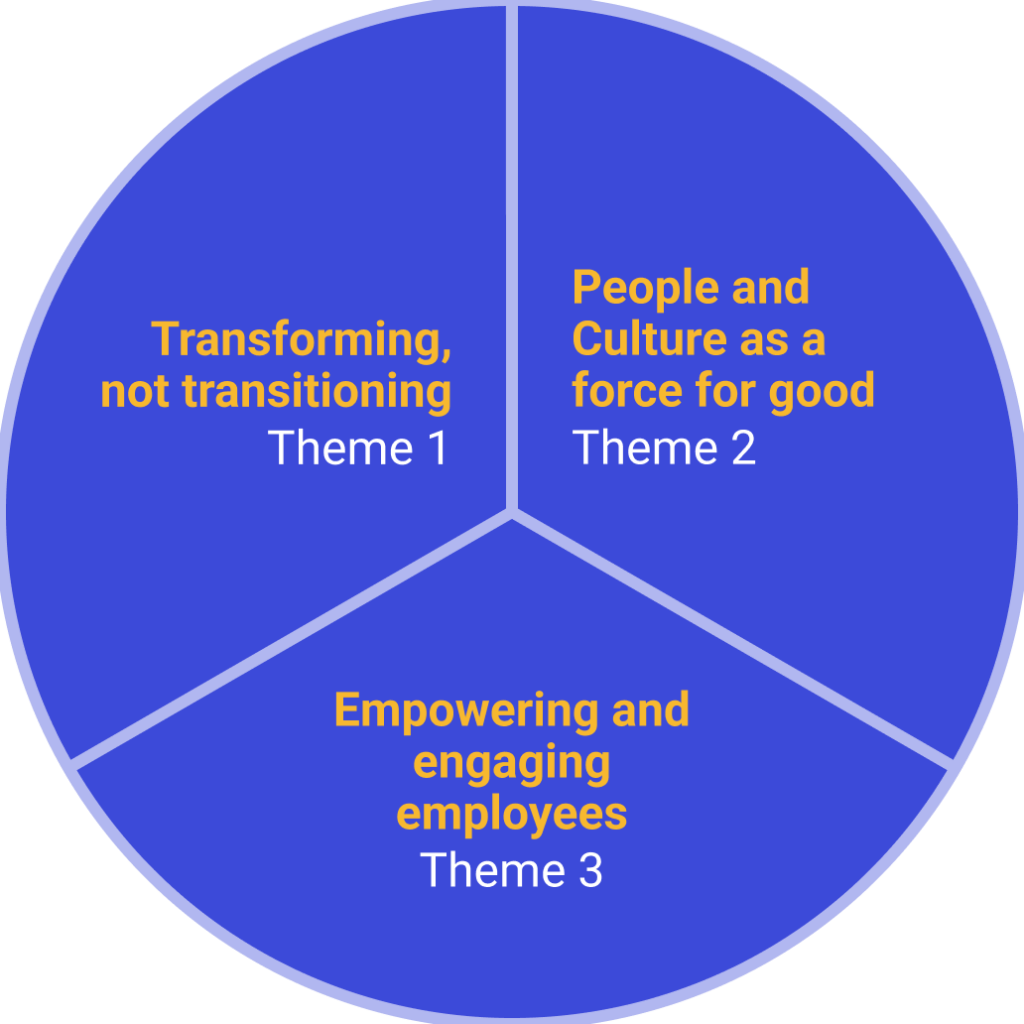Redefining culture, connection and the future of work
To say it’s been a rollercoaster few years in people management would be an understatement. Although things aren’t back to ‘normal’, we have entered a kind of normalization phase. Workers and managers are collectively figuring out what the future will look like. Leading the way into that bright, bold, weird and wonderful future will be Human Resources – also known as HR, People Operations, People and Culture, Human Capital, Employee Experience Architect and countless other names.
Today’s HR professionals have a lot on their plate
Whatever you call it, HR has a wide remit in a dynamic landscape. Today’s function is an evolved, multidisciplinary advisor to all. As we try to map where this evolution will end up, we first need to clarify HR priorities for the coming year. Otherwise, there’s a real risk of job creep, missed opportunities and misalignment.

Three themes for 2024
We see HR’s priorities grouped into 3 themes. Each theme covers 3 priorities with an extensive list of sub-priorities that rise and fall in the pecking order depending on the organization.

Theme 1: Transforming, not transitioning
In the rapidly evolving landscape of human resources (HR), the focus is on transforming, not just transitioning. Over the next year, organizational development, design, HR strategy, and change management will amalgamate into a strategic advisory function, centering on organizational transformation.
The role of HR has fundamentally shifted, as indicated by a Sage poll, with 91% of HR leaders and 96% of C-suite executives acknowledging this change. Gartner’s research highlights three key priorities for 2024: growth, technology, and talent.
To prepare for this evolution, HR should define a strategic vision, assess analytics, and set clear boundaries. The shift from “Human Resources” to “People and Culture” emphasizes a move from administrative and operational excellence to creating an environment aligned with mission, vision, and values.
In the hybrid work environment, HR’s role is pivotal in maintaining and strengthening organizational culture. Leveraging technology, particularly AI, is identified as a significant opportunity for step-change growth.
However, careful consideration and proactive training are essential to ensure effective technology use. People and Culture leaders are expected to establish safeguards and choose tech solutions that facilitate employee well-being, automate tasks, contribute to organizational goals, and integrate with other systems.
As the lines between human and technological capabilities blur, the key takeaway is that humans, augmented by AI, are poised to replace those without it, fostering increased productivity, engagement, and satisfaction.
Theme 2 : People and Culture as a force for good
Through focused Diversity, Equity, and Inclusion (DEI) initiatives, leaders in the People and Culture sector will be essential in promoting good change in 2024. Employee engagement is negatively impacted by a worrying trend found in the layoff data analysis: DEI roles are disproportionately affected.
Leaders need to address this by emphasizing systemic DEI policies, such as inclusive benefits, fair recruiting practices, equal remuneration, and impartial practices. Leaders in People and Culture must strike a balance between the needs of profitable growth and employee well-being as their organizations strive for purpose-driven expansion.
In the productivity paradox, personal stress is associated with geopolitical tensions; purpose-led growth is suggested as a potential remedy. A people-first approach is necessary in this situation, and leaders in people and culture can support it by using reliable workday data to match worker productivity with company objectives.
Leaders must aggressively support, oversee, and document sustainability programs in order to fulfill Environmental, Social, and Governance (ESG) obligations. Sustainability projects are also becoming more and more prominent. This position includes following policies, encouraging a sustainable culture, and helping to implement programs that support a comprehensive strategy for achieving sustainability goals.
Theme 3: Empowering and engaging employees
The function of People and Culture is critical in resolving the growing trust gaps between managers and employees in the complicated landscape of modern workplaces. A lack of training, excessive responsibilities, and managerial burnout are harming trust and causing dissatisfaction and disengagement.
People and Culture leaders need to help managers reset expectations, encourage self-determination, and cultivate positive behaviors in order to empower and engage their workforce.
Furthermore, conflicts can be repaired by putting into practice bridge-building activities including understanding both viewpoints, figuring out the underlying causes, and setting up feedback systems. It is imperative that the employer brand be completely redesigned, with an emphasis on inclusiveness, social responsibility, competitive pay, flexible work schedules, and work-life balance.
In 2024, addressing employee well-being will be crucial for creating a unique employer brand due to the growth in burnout. Effectively preparing for the future of work is recognizing the transition towards hybrid work with a focus on participation, investing in training and development, anticipating talent needs, and understanding present challenges.
Leaders in visionary people and culture are talking about why people work as much as where they do, realizing that stress levels are more influenced by employee engagement than by location.
Conclusion
As we navigate HR’s evolution in 2024, the multifaceted role of Human Resources has never been more pivotal. The dynamic landscape demands a proactive approach, and the three themes – Transforming, not transitioning; People and Culture as a force for good; and Empowering and engaging employees – encapsulate the core priorities for HR professionals.
The transformation from traditional HR to strategic advisory roles underscores the importance of organizational development, technology integration, and talent management. People and Culture leaders are not only steering DEI efforts but also championing purpose-led growth and sustainability initiatives to balance productivity and well-being.
Moreover, in the face of widening trust gaps, these leaders are crucial in rebuilding relationships, fostering engagement, and addressing the burnout epidemic. As we stand on the brink of a new era in the world of work, HR’s ability to redefine culture, connection, and the future of work will undoubtedly shape the trajectory of organizations in the years to come.
The journey ahead is challenging, but with strategic vision, adaptability, and a commitment to employee well-being, HR is poised to lead the way into a bright and innovative future.

Carlo Borja is the Content Marketing Manager of Time Doctor, a workforce analytics software for distributed teams. He is a remote work advocate, a father and a coffee junkie.


